Inbox Zero: The practical guide to freeing your mind and being more creative
If you want to feel that you are in control of your e-mail inbox and not the other way around, you should try Inbox Zero.
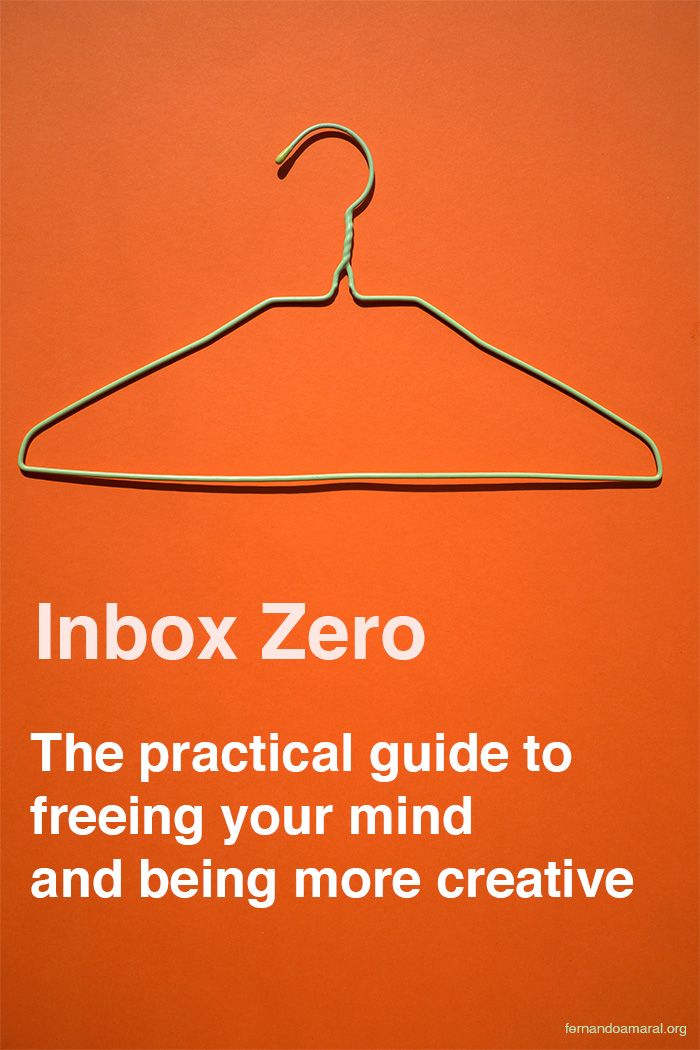
E-mail is the thief of quality time and creativity.
When your inbox fills faster than you can empty it and the total number of unread e-mails grows bigger every day, it can be hard to stay focused on the work that matters.
Inbox Zero is a methodology to manage the constant flow of e-mail landing in your inbox that maximizes clarity. The main goal is to clear your mind of the monotonous task of handling e-mail and concentrate on the work you purposely want to get done.
My Inbox Zero success story
I've been guilty of driving e-mail accounts to Inbox Infinity all my life. I've learned to live with thousands of unread e-mails, much to the visible disgust of my obsessive-compulsive friends and colleagues.
That was the old me. Six months ago, I started a new job, and that meant I got a brand new e-mail address to go with it. I literally had zero unread e-mails in my inbox that day.
Maybe that's cheating, but for me, it was the perfect opportunity to implement an Inbox Zero system from scratch and to maintain an organized inbox for the first time.
Thousands of e-mails later, I can say that the system is working, and I'm never going back to the infinite inbox I had before.
The complete guide to Inbox Zero on Gmail
I have documented how I set up my new Gmail account from day one, and I'm sharing the exact steps I took. Feel free to adapt to your own needs, style, and tools.
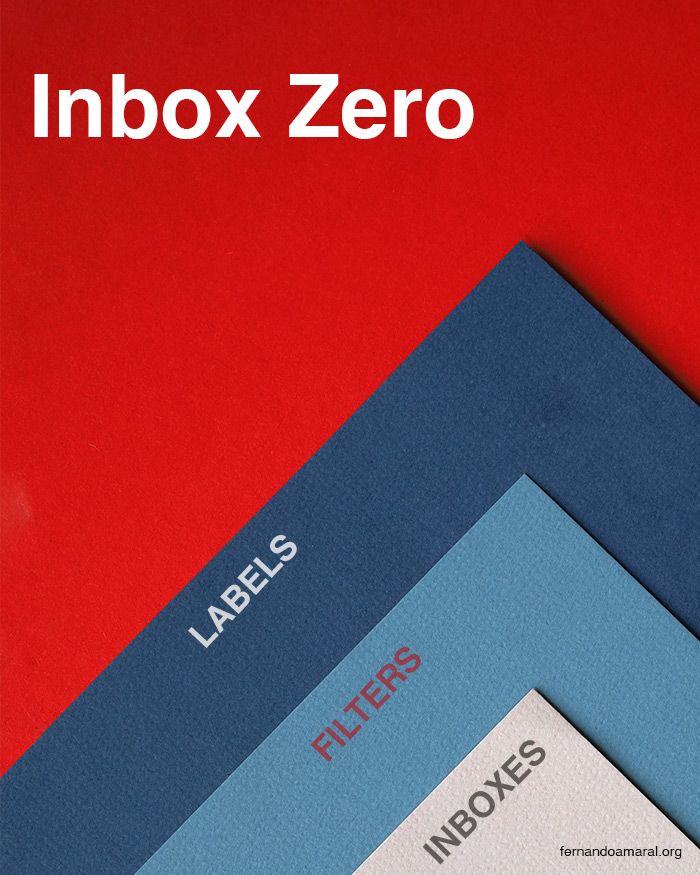
Inbox Zero comprises three key concepts: labels, filters, and inboxes.
1. Labels
You can classify messages in any way imaginable by applying labels. They work like tags in the sense that a message can have multiple labels attached.
Navigate to the Labels tab inside Gmail's Settings to see all the existing labels, create new ones, and adjust their visibility.
Keep in mind that automatic filters and multiple inboxes will only be as good as your labeling system. You want the list to be thorough but not overwhelming.
I recommend creating two distinct sets of labels - one by content type and another by action type.
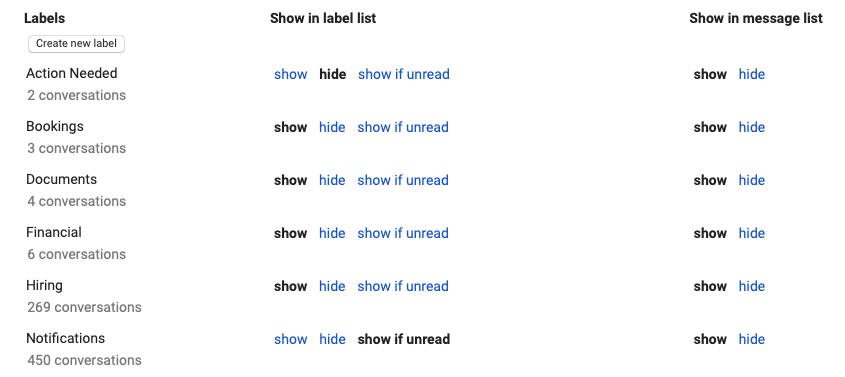
Label by content type
Think of the typical types of content that messages fall into and visualize how they could be archived inside folders for easier access.
That's how I came up with my content labels.
Team: Messages from my team.
Hiring: Job applications and messages from candidates in a recruiting process.
Documents: Messages containing documentation that I might need to retrieve later.
Bookings: Messages related to travel bookings (Yes, I used to travel...)
Notifications: All kinds of automatic messages from tools like Calendar, Asana, Slack, Facebook Ads, etc...
If these labels look too broad, you can make them more granular with sub-labels like Team - marketing, Team - leadership, Bookings - hotels, Bookings - planes, Documents - contracts, Documents - invoices, etc...
Label by action type
Now, let's change the mindset and think of how messages can be grouped according to the required next steps.
Ideally, every e-mail would be processed immediately, and you would be done with it. In the real world, that's not always possible.
Here are the labels I've defined.
Action Needed - For e-mails that require me to act upon them.
Waiting - When I'm waiting on something or someone to continue the e-mail thread.
Read Later - When I want to read the content later.
Once you set up the labeling system, you have to start using it.
Click the label button when reading an e-mail to assign one or multiple labels to it. You can also drag messages from the inbox to a label on the sidebar to move it there.
Adding a custom color to each label will make your folders and inboxes much more visual. You can change the label color in the left sidebar.
2. Filters
Using filters, I automatically assign labels to e-mails as they land on my inbox and trigger actions like marking messages as read or even skipping the inbox altogether.
To create and manage filters, navigate to the Filters and blocked addresses tab inside Settings.
A filter is composed of two parts: the match criteria and the action list.
First, fill in the desired criteria that will act as a trigger and click Create filter. Then, configure the combination of steps to be executed.
A simple filter can search for a specific sender and automatically apply a label to every message it can find, now and in the future.
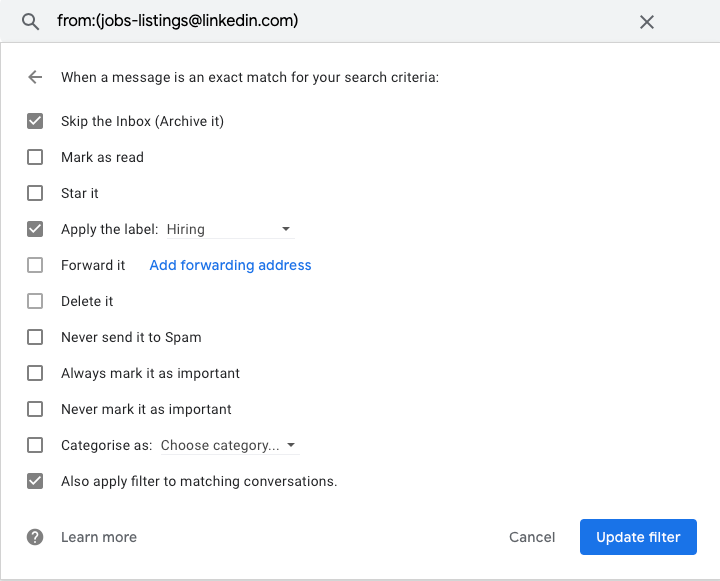
When creating a new filter, if you want to apply it to past messages as well, check the last box in the list.
Here are some examples of automatic filters that I have, based on the sender:
Matches: from:(@tonicapp.com)
Do this: Apply label "Tonic App"
Matches: from:(jobs-listings@linkedin.com)
Do this: Skip Inbox, Apply label "Hiring"
Matches: from:(advertise-noreply@support.facebook.com)
Do this: Skip Inbox, Apply label "Notifications"
Automation is key to efficient time management. The time you invest into building your own automated filters will come back to you in multiples.
3. Inboxes
Gmail can present messages in one or multiple inboxes, with customizable layouts and settings.

To take advantage of the labeling and filtering system I've created, I'm using multiple inboxes with a layout that mirrors it.
You can configure up to five sections besides the regular inbox. Navigate to the Inbox tab inside Settings and choose Inbox Type: Multiple Inboxes.
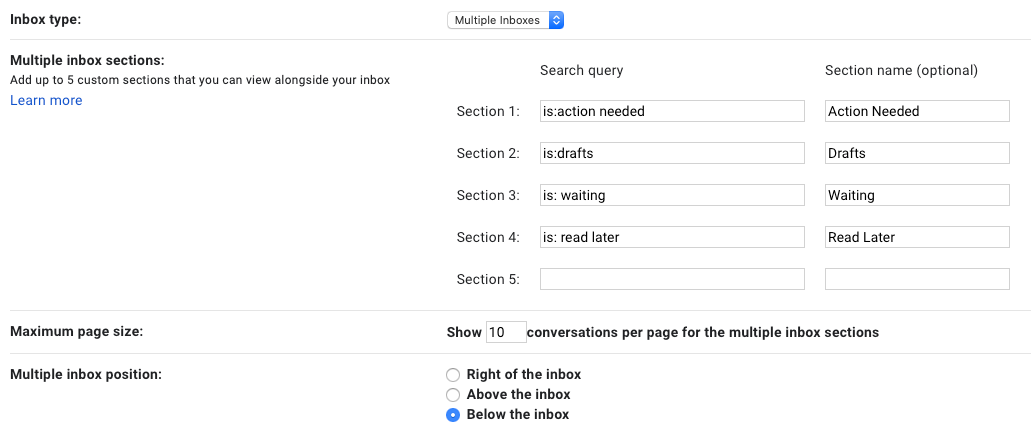
I'm using four sections. Three correspond to my action type labels: Action Needed, Waiting, and Read Later - by this order. The fourth is the Drafts section. I keep the sections under the regular inbox, so new e-mails always appear on top.
Every time I process and empty the first inbox, I'm left with the Action Needed on top, where my attention should be.
Remember that filters can archive some messages in their respective folders automatically, bypassing all the inboxes!
Conclusion
By now, you've probably realized how all the pieces fit together to free your mind from unnecessary tasks.
Six months after starting to use the Inbox Zero method, I have no unread e-mails, two messages inside Action Needed, and nine marked Waiting.
Sometimes I still procrastinate and accumulate several open threads on my primary inbox or simply push them to another box to deal with later. I don't reach inbox zero every single day. However, it's always a volume that I can control and process once I have some time.
When I look back one year to my previous system, I remember randomly created folders, a never-ending backlog of hundreds, if not thousands of unread messages, and the constant feeling of things falling through the cracks.
I'm never going back to that.
